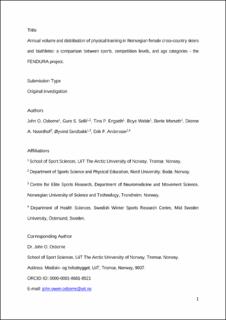| dc.contributor.author | Osborne, John Owen | |
| dc.contributor.author | Solli, Guro Strøm | |
| dc.contributor.author | Engseth, Tina Pettersen | |
| dc.contributor.author | Welde, Boye | |
| dc.contributor.author | Morseth, Bente | |
| dc.contributor.author | Noordhof, Dionne Adriana | |
| dc.contributor.author | Sandbakk, Øyvind Bucher | |
| dc.contributor.author | Andersson, Bror Erik Petrus | |
| dc.date.accessioned | 2023-11-21T13:37:42Z | |
| dc.date.available | 2023-11-21T13:37:42Z | |
| dc.date.created | 2023-10-20T12:46:07Z | |
| dc.date.issued | 2023 | |
| dc.identifier.citation | International Journal of Sports Physiology and Performance 2023 | en_US |
| dc.identifier.issn | 1555-0265 | |
| dc.identifier.uri | https://hdl.handle.net/11250/3103875 | |
| dc.description.abstract | Purpose To describe and compare the annual physical training characteristics between Norwegian female cross-country (XC) skiers and biathletes across competition levels and age categories. Methods Daily training sessions for one year were recorded for 45 XC skiers and 26 biathletes, comprising international/national-team [inter(national)] and non-national/regional-team members (non-national) of both junior and senior age. Endurance, strength, flexibility, speed, and power training sessions were recorded. Data included exercise modality, intensity, and duration. Data were analysed using linear mixed-effects models. Results The total annual physical training volume consisted of ~90% endurance training for both groups, although XC skiers had significantly higher total volumes (~10%; p=.003; d=0.78) than biathletes. Senior XC skiers performed more training hours of skiing and/or roller skiing compared to biathletes over the season. However, biathletes compensated for this lower volume by more skating, and higher proportion of endurance training as skiing (81±17%), compared to XC skiers (68±16%; p<.001; d=0.94). Overall, (inter)national level athletes completed a higher annual training volume than non-national level athletes (740±90 h vs 649±95 h; p=.004 d=0.81). Although juniors reported less endurance volume than seniors, they maintained a relatively stable level of endurance training across the preparatory and competition period, unlike senior athletes. Conclusion The higher annual physical training volume by XC skiers compared to biathletes is likely caused by the different demands of the two sports; XC skiing necessitates training for two skiing styles, while biathlon requires additional shooting practice. However, biathletes compensate with a higher proportion of ski training, particularly in the skating technique. | en_US |
| dc.description.abstract | Annual Volume and Distribution of Physical Training in Norwegian Female Cross-Country Skiers and Biathletes: A Comparison Between Sports, Competition Levels, and Age Categories — The Female Endurance Athlete Project | en_US |
| dc.language.iso | eng | en_US |
| dc.publisher | Human Kinetics | en_US |
| dc.relation.uri | https://doi.org/10.1123/ijspp.2023-006 | |
| dc.title | Annual Volume and Distribution of Physical Training in Norwegian Female Cross-Country Skiers and Biathletes: A Comparison Between Sports, Competition Levels, and Age Categories — The Female Endurance Athlete Project | en_US |
| dc.title.alternative | Annual Volume and Distribution of Physical Training in Norwegian Female Cross-Country Skiers and Biathletes: A Comparison Between Sports, Competition Levels, and Age Categories — The Female Endurance Athlete Project | en_US |
| dc.type | Journal article | en_US |
| dc.type | Peer reviewed | en_US |
| dc.description.version | acceptedVersion | en_US |
| dc.source.journal | International Journal of Sports Physiology and Performance (IJSPP) | en_US |
| dc.identifier.doi | 10.1123/ijspp.2023-0067 | |
| dc.identifier.cristin | 2186746 | |
| dc.relation.project | Tromsø forskningsstiftelse: 19_FENDURA_BW | en_US |
| cristin.ispublished | true | |
| cristin.fulltext | postprint | |
| cristin.qualitycode | 1 | |
